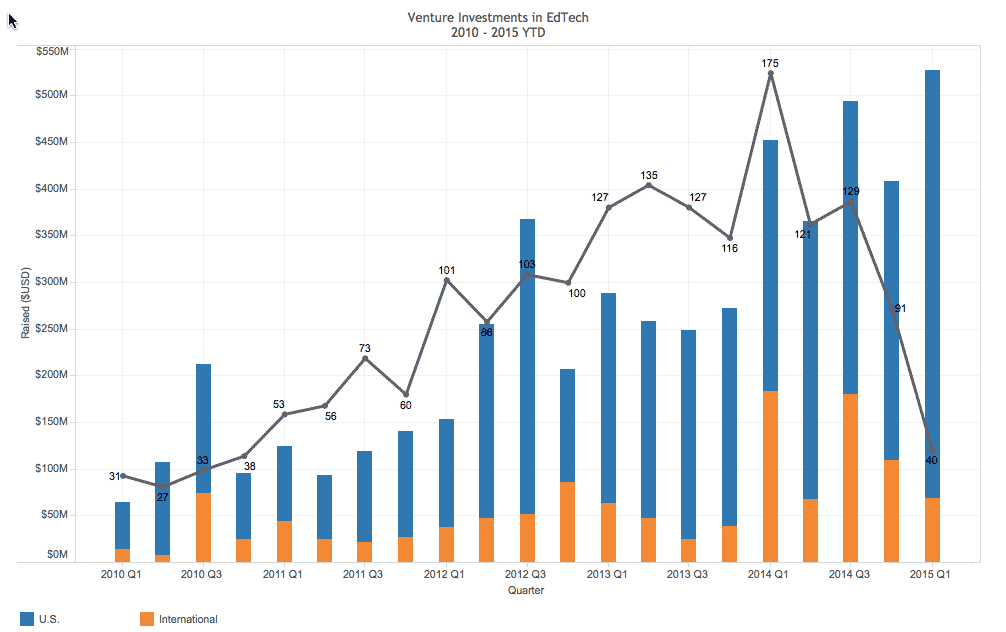V enture capitalists really hit the books in 2014. Edtech companies stockpiled nearly $2 billion in venture funding — a 50 percent jump from 2013.
For millions of children in the American education system, more venture money doesn’t necessarily translate to a better education. The U.S., which has seen over 75 percent of the edtech capital committed in the past five years, still trails behind the worldwide average in K-12 education scores.
Click here to interact with the chart
Until recently, the majority of the startup community has been absent i discussions around education reform. Entrepreneurs and venture investors have largely ignored the K-12 market and made bigger bets on adult education startups instead — like professional edtech platform lynda.com, whose $186 million raised in January is the largest edtech financing seen in the past six years, according to CrunchBase data.
Now the results from edtech’s banner year are in, and it appears a revival in K-12 investing is underway.
In 2014, startups with a primary or secondary education focus accounted for nearly $400 million of the total $1.8 billion in venture capital committed, according to a report compiled by GSV Advisors. This is more than double 2013’s total.
“We’ve been doing education for 17 years, and there were probably ten years there where we were the only people who touched a K-12 company because everybody hated it. It was too hard and the procurement was awful,” says Deborah Quazzo, founder of GSV and member of the Chicago Board of Education.
The venture firms that did invest got burned. “If you look back 10 years, Kleiner and Accel put $225 million dollars into a company called Lightspan, and it finally sold for $50 million, which was lucky. It was just too early — teachers were not ready, schools were not wired, funding wasn’t available,” says Quazzo.
But today, devices are cheaper, students are more tech-savvy, and classrooms are better connected.
“Chromebooks are now less than $300 bucks, they cost what a textbook used to cost,” says Tom Vander Ark, edtech advocate and managing partner at Learn Capital. “If you make good use of open content, you can actually save money by shifting to a higher access environment,” Vander Ark points out.
School districts have already started experimenting with equal access solutions, but a handful of failures have proven that implementing technology at scale is not an easy task.
In 2013, LA Unified School District agreed to funnel $1.3 billion into a district-wide initiative that would give each student an iPad. The program was plagued by problems from the start — teachers were not prepared, Internet connection was spotty, and students quickly bypassed security blockers. LAUSD finally suspended the program in December in the midst of an FBI investigation into the bidding process that won Pearson and Apple the district-wide contract.
“I’m less of an enthusiast about ‘let’s just get every kid an iPad and we’ll figure it out,’” says Mitch Kapor, founder of social impact fund Kapor Capital. “The idea that you could just throw technology at a problem and raise up kids from low-income backgrounds? It was predictable that it wasn’t going to work.”
Silicon Valley’s Udacity learned a similar lesson the year before when it partnered with San Jose State to offer online courses for high school students in the local district. The program was intended to provide equal access to college prep courses for low-income high school students, but its failure revealed a digital divide far wider than expected.
The failure of these experiments have led some to conclude that edtech isn’t leveling the playing field at all — in fact, it’s making it worse. Researchers are drawing on the idea that early advantages tend to multiply over time to posit that a tablet in the hands of a disadvantaged student is not the same as a tablet in the hands of his privileged counterpart.
“There’s a heightened disappointment cycle about new technology that plays out in general in our ecosystem, and we’re seeing that play out to some extent in edtech,” says Kapor. “When new technology in the classroom starts happening, some people get very excited and think of it as a panacea. It attracts very high amounts of money, it raises expectations, and those expectations aren’t met.”
The latest batch of venture-backed edtech companies are making progress. According to Kapor, several of Kapor Capital‘s startups have already crossed the million student threshold, with some startups penetrating 30-40% of all public schools. The two-year-old startup Newsela, which tailors news-centric content to individual reading levels, has already registered teachers in half the schools in the country.
Read the rest of the article at TechCrunch







